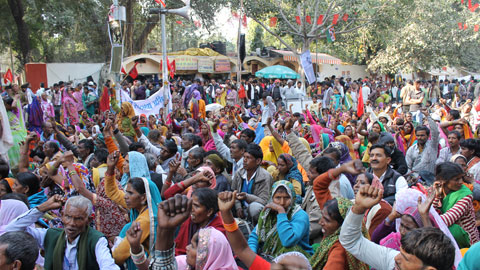Environmental justice defenders victims of violence and murder

Grassroots movements halt environmental degradation in up to 27% of environmental conflicts worldwide, according to a study by the ICTA-UAB. Activists are victims of violence in 18% of cases, and of murder in 13%, and figures increase when indigenous peoples are involved.
Activists protesting against environmental injustices around the world suffer from high rates of criminalization, physical violence and murder. This is the result of a study developed by researchers from the Institute of Environmental Science and Technology of the Universitat Autònoma de Barcelona (ICTA-UAB) that presents the largest analysis of environmental conflicts up to date. The study highlights that these impacts are especially frequent when indigenous peoples are involved, and in conflicts related to mining and land use.
Researchers from the Environmental Justice project (ENVjustice) have analysed 2,743 cases of environmental conflicts worldwide registered in the global Atlas of Environmental Justice (EJAtlas), an interactive map that identifies existing ecological distribution conflicts. The study, published in the journal Global Environmental Change, is a landmark advancement in the field of statistical and comparative political ecology.
The global movement for environmental justice is composed of local activism against fossil fuel extraction, open cast mining, tree plantations, hydropower dams and other extractive industries, and against waste disposal in the form of incineration or dumps. "This is the environmentalism of the poor and the indigenous", states Joan Martínez-Alier,ICTA-UAB economist and principal researcher of the ENVjustice project. Arnim Scheidel, main author of the study says that "to support environmental defenders effectively, better knowledge about the underlying environmental conflicts is needed, as well as a profound understanding of the factors that enable activists to mobilize successfully for environmental justice".
The researchers describe the characteristics of environmental conflicts and the environmental defenders involved, as well as their successful mobilization strategies. Analysed data show that environmental defenders are frequently members of vulnerable groups who employ largely non-violent protest forms. However, their activism comes at a heavy cost. In 20% of environmental conflicts, activists face criminalization, including fines, legal persecution and prison terms. In 18% of cases, activists are victims of physical violence, and in 13% of cases, they are murdered. When indigenous people are involved, these figures significantly increase to 27% in criminalization, 25% in violence and 19% in murders.
In 11% of cases globally, protesters contributed to halt environmentally destructive and socially conflictive projects, defending the environment and livelihoods. "Combining strategies of preventive mobilization, protest diversification and litigation can increase this success rate significantly to up to 27%", explains Juan Liu, corresponding author of the study. The research also highlights the role of women as leaders in the mobilizations (21%), sometimes because of being disproportionally affected by the environmental and health impacts of these conflicts.
Bottom-up mobilizations for more sustainable and socially just uses of the environment occur worldwide across countries in all income groups, "testifying to the existence of various forms of grassroots environmentalism as a promising force for sustainability", the researchers conclude.
Picture: Farmers' mobilizations at Jantar Mantar, Delhi, Dec. 2014. Author: Daniela Del Bene.
Referència:
Scheidel A, Del Bene D, Liu J, Navas G, Mingorría S, Demaria F, Avila S, Roy B, Ertör I, Temper L, Martinez-Alier J. 2020. Environmental Conflicts and Defenders: a global overview. Global Environmental Change 2020. https://doi.org/10.1016/j.gloenvcha.2020.102104






